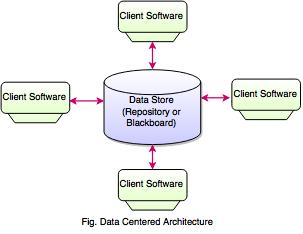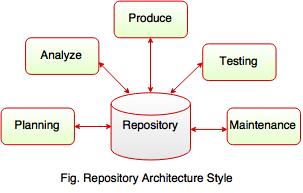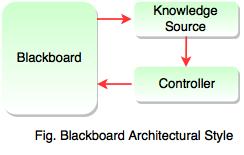Data Centered Architecture
Introduction to Data Centered Architecture
What is Data Centered Architecture?- Data Centered Architecture is a layered process which provides architectural guidelines in data center development.
- Data Centered Architecture is also known as Database Centric Architecture.
- This architecture is the physical and logical layout of the resources and equipment within a data center facility.
- Data Centered Architecture serves as a blueprint for designing and deploying a data center facility.
- It is usually created in the data center design and constructing phase.
- This architecture specifies how these devices will be interconnected and how physical and logical security workflows are arranged.

- The above figure shows the architecture of Data Centered Architecture. In this architecture, the data is centralized and accessed frequently by other components which modify the data. The main purpose of data centered architecture is to achieve integrality of data.
- The example of data centered architecture is the Web architecture, which has a common data schema, follows hypermedia data model and processes communicate through the use of shared web-based data services.
- This architecture consists of different components that communicate through shared data repositories.
There are two types of Components:
1. Central Data
2. Data Accessor
1. Central Data- Central data provides permanent data storage.
- Central data represents the current state.
2. Data Accessor- Data accessor is a collection of independent components.
- It operates on the central data store, performs computations and displays the results.
- Communication can be done between the data accessors is only through the data store.
There are two categories which differentiates the architecture flow of control:
1. Repository Architecture Style
2. Blackboard Architecture Style
1. Repository Architecture Style- Repository architecture is a collection of independent components which operate on central data structure.
- Information System, Programming Environments, Graphical Editors, AI Knowledge Bases, Reverse Engineering System are the examples of Repository Architecture Style.
- It includes central data structure.
- Repository architecture style is very important for data integration introduced in a variety of applications including software development, CAD etc.
- Repository architecture style makes change to the data structure trigger computations.
- This architecture is suitable for applications in which the central issues are establishing and maintaining a complex central body of information.

The above figure shows the repository architecture style. In this architecture, the data store is passive and the software clients or components of the data store are active which controls the logic flow and checks the data store for changes.
Advantages of Repository Architecture Style- Repository Architecture Style provides data integrity, backup and restore features.
- It reduces overhead of transient data between software components.
- It has an efficient way to store large amount of data.
- It has a centralized management which consists of backup, security and concurrency control.
Disadvantages of Repository Architecture Style- In repository architecture style, evolution of data is difficult and expensive.
- It has high dependency between data structure of data store and its software components or clients.
2. Blackboard Architecture Style- Blackboard architecture style is an artificial intelligence approach which handles complex problem, where the solution is the sum of its parts.
- In this architecture, the logical flow is determined by the current data status in data store because the data store is active and its clients are passive.
- Blackboard architecture style has a blackboard component which acts as a central data repository.
- It is used in location-locomotion, data interpretation and environmental changes for solving the problem.
- It is an approach to processing agent communication centrally.
There are major three components:
1. Knowledge Source
2. Blackboard
3. Control Shell
 1. Knowledge Source
1. Knowledge Source- Knowledge source is also known as Listeners or Subscribers. They are distinct and independent units.
- Knowledge source solves the problem and aggregate partial results.
- It provides specific expertise needed by the application.
- The interaction between the knowledge source takes place uniquely through the blackboard.
2. Blackboard- Blackboard is a shared repository of problems, solutions, suggestions and contributed information.
- It can be thought of as a dynamic library of an information to the current problem which have been published by other knowledge sources.
- In blackboard data structure, the problem solving state is organized into an application-dependent hierarchy and then knowledge source makes change to the blackboard which leads incrementally to a solution to the problem.
3. Control Shell- In Control shell, it controls the flow of problem-solving activity in the system.
- It manages the task and checks the work state.
Advantages of Blackboard Architecture Style- Blackboard architecture style provides concurrency which allows knowledge sources to work in parallel.
- This architecture supports experimentation for hypotheses and reusability of knowledge source components.
- It allows blackboard applications to adapt to changing requirements.
- It allows the new knowledge sources which can be developed and applied to the system without affecting on the existing system.
- It performs more than one knowledge source in the same function and therefore it helps to improve both problem solving efficiency and the quality of the eventual solution.
- New applications can easily constructed using existing knowledge source.
Disadvantages of Blackboard Architecture Style- Blackboard architecture style has the provision of tight dependency between the blackboard and knowledge source.
- It has difficulty in making a decision for reasoning termination.
- It has an issue in synchronization of multiple agents.


